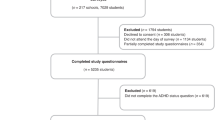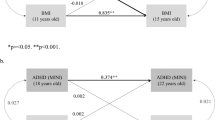Abstract
Objective:
Preliminary evidence suggests a comorbidity between attention-deficit/hyperactivity disorder (ADHD) and obesity. This study was carried out to identify the clinical characteristics of obese adolescents with a higher probability of ADHD and advance the understanding of the potential factors underlying the comorbidity between obesity and ADHD. We evaluated the association between ADHD symptoms and bulimic behaviors, depressive and anxiety symptoms, degree of obesity, pubertal stage, age and gender in a clinical sample of obese adolescents.
Design:
Cross-sectional study.
Subjects:
Ninety-nine severely obese adolescents aged 12–17 years.
Measurements:
Subjects filled out the Bulimic Investigatory Test, Edinburgh, the Beck Depression Inventory and the State-Trait Anxiety Inventory for Children. Their parents completed the Conners Parent Rating Scale, which assesses ADHD symptoms. The degree of overweight was expressed as body mass index-z score. Puberty development was clinically assessed on the basis of Tanner stages.
Results:
Bulimic behaviors were significantly associated with ADHD symptoms after controlling for depressive and anxiety symptoms. The degree of overweight, pubertal stage, age and gender were not significantly associated with ADHD symptoms.
Conclusion:
Obese adolescents with bulimic behaviors may have a higher probability to present with ADHD symptoms independently from associated depressive or anxiety symptoms. The degree of overweight, pubertal stage, age and gender might not be useful for detecting obese adolescents with ADHD symptoms. Therefore, we suggest systematic screening for ADHD in obese adolescents with bulimic behaviors. Further studies are needed to understand which specific dimension of ADHD primarily accounts for the association with bulimic behaviors. Future research should also investigate the causal link between bulimic behaviors and ADHD and explore potential common neurobiological alterations. This may lead to a better understanding of the effectiveness of stimulants for the treatment of bulimic behaviors in obese subjects.
This is a preview of subscription content, access via your institution
Access options
Subscribe to this journal
Receive 12 print issues and online access
$259.00 per year
only $21.58 per issue
Buy this article
- Purchase on Springer Link
- Instant access to full article PDF
Prices may be subject to local taxes which are calculated during checkout
Similar content being viewed by others
References
Biederman J . Attention-deficit/hyperactivity disorder: a selective overview. Biol Psychiatry 2005; 57: 1215–1220.
Dulcan M . Practice parameters for the assessment and treatment of children, adolescents, and adults with attention-deficit/hyperactivity disorder. American Academy of Child and Adolescent Psychiatry. J Am Acad Child Adolesc Psychiatry 1997; 36 (Suppl): 85S–121S.
American Psychiatric Association (APA). Diagnostic and Statistical Manual of Mental Disorders, 4th edn. American Psychiatric Association: Washington, DC, 1994.
Rappley MD . Clinical practice. Attention deficit-hyperactivity disorder. N Engl J Med 2005; 352: 165–173.
American Academy of Pediatrics. Clinical practice guideline: diagnosis and evaluation of the child with attention-deficit/hyperactivity disorder. Pediatrics 2000; 105: 1158–1170.
Agranat-Meged AN, Deitcher C, Goldzweig G, Leibenson L, Stein M, Galili-Weisstub E . Childhood obesity and attention deficit/hyperactivity disorder: a newly described comorbidity in obese hospitalized children. Int J Eat Disord 2005; 37: 357–359.
Holtkamp K, Konrad K, Muller B, Heussen N, Herpertz S, Herpertz-Dahlmann B et al. Overweight and obesity in children with attention deficit/hyperactivity disorder. Int J Obes Relat Metab Disord 2004; 28: 685–689.
Altfas JR . Prevalence of attention deficit/hyperactivity disorder among adults in obesity treatment. BMC Psychiatry 2002; 2: 9.
Levitan RD, Masellis M, Lam RW, Muglia P, Basile VS, Jain U et al. Childhood inattention and dysphoria and adult obesity associated with the dopamine D4 receptor gene in overeating women with seasonal affective disorder. Neuropsychopharmacology 2004; 29: 179–186.
Bazar KA, Yun AJ, Lee PY, Daniel SM, Doux JD . Obesity and ADHD may represent different manifestations of a common environmental oversampling syndrome: a model for revealing mechanistic overlap among cognitive, metabolic, and inflammatory disorders. Med Hypotheses 2005; 66: 263–269.
Comings DE, Blum K . Reward deficiency syndrome: genetic aspects of behavioral disorders. Prog Brain Res 2000; 126: 325–341.
Blum K, Braverman ER, Holder JM, Lubar JF, Monastra VJ, Miller D et al. Reward deficiency syndrome: a biogenetic model for the diagnosis and treatment of impulsive, addictive, and compulsive behaviors. J Psychoactive Drugs 2000; 32 (Suppl I–IV): 112.
Heiligenstein E, Keeling RP . Presentation of unrecognized attention deficit hyperactivity disorder in college students. J Am Coll Health 1995; 43: 226–228.
Mattos P, Saboya E, Ayrao V, Segenreich D, Duchesne M, Coutinho G . Comorbid eating disorders in a Brazilian attention-deficit/hyperactivity disorder adult clinical sample. Rev Bras Psiquiatr 2004; 26: 248–250.
Murphy K, Barkley RA . Attention deficit hyperactivity disorder adults: comorbidities and adaptive impairments. Compr Psychiatry 1996; 37: 393–401.
Field AE, Camargo Jr CA, Taylor CB, Berkey CS, Frazier AL, Gillman MW et al. Overweight, weight concerns, and bulimic behaviors among girls and boys. J Am Acad Child Adolesc Psychiatry 1999; 38: 754–760.
Nunes MA, Barros FC, Anselmo Olinto MT, Camey S, Mari JD . Prevalence of abnormal eating behaviours and inappropriate methods of weight control in young women from Brazil: a population-based study. Eat Weight Disord 2003; 8: 100–106.
Duncan AE, Neuman RJ, Kramer J, Kuperman S, Hesselbrock V, Reich T et al. Are there subgroups of bulimia nervosa based on comorbid psychiatric disorders? Int J Eat Disord 2005; 37: 19–25.
Kaye WH, Bulik CM, Thornton L, Barbarich N, Masters K . Comorbidity of anxiety disorders with anorexia and bulimia nervosa. Am J Psychiatry 2004; 161: 2215–2221.
O'Brien KM, Vincent NK . Psychiatric comorbidity in anorexia and bulimia nervosa: nature, prevalence, and causal relationships. Clin Psychol Rev 2003; 23: 57–74.
Comings DE, Chen C, Wu S, Muhleman D . Association of the androgen receptor gene (AR) with ADHD and conduct disorder. Neuroreport 1999; 10: 1589–1592.
Jesmin S, Togashi H, Sakuma I, Mowa CN, Ueno K, Yamaguchi T et al. Gonadal hormones and frontocortical expression of vascular endothelial growth factor in male stroke-prone, spontaneously hypertensive rats, a model for attention-deficit/hyperactivity disorder. Endocrinology 2004; 145: 4330–4343.
King JA, Barkley RA, Delville Y, Ferris CF . Early androgen treatment decreases cognitive function and catecholamine innervation in an animal model of ADHD. Behav Brain Res 2000; 107: 35–43.
King JA, Kelly TA, Delville Y . Adult levels of testosterone alter catecholamine innervation in an animal model of attention-deficit hyperactivity disorder. Neuropsychobiology 2000; 42: 163–168.
Frelut ML . Diagnostic methods in childhood obesity. In: Les Editions (ed). Obesity, Detection and Prevention in Children. INSERM: Paris, 2000. pp 99–116.
Rolland-Cachera MF, Cole TJ, Sempe M, Tichet J, Rossignol C, Charraud A . Body mass index variations: centiles from birth to 87 years. Eur J Clin Nutr 1991; 45: 13–21.
Tanner JM . Growth at Adolescence, 2nd edn, Blackwell Oxford: United Kingdom, 1962.
Henderson M, Freeman CP . A self-rating scale for bulimia. The ‘BITE’. Br J Psychiatry 1987; 150: 18–24.
Ghazal N, Agoub M, Moussaoui D, Battas O . Prevalence of bulimia among secondary school students in Casablanca. Encephale 2001; 27: 338–342.
Beck AT, Beamesderfer A . Assessment of depression: the depression inventory. Mod Probl Pharmacopsychiatry 1974; 7: 151–169.
Collet L, Cottraux J . The shortened Beck depression inventory (13 items). Study of the concurrent validity with the Hamilton scale and Widlocher's retardation scale. Encephale 1986; 12: 77–79.
Spielberger CD, Gorsuch RL, Lushene RE . Manual for the State-Trait Anxiety Inventory for Children. Consulting Psychologist Press: Palo Alto, CA, 1973.
Vila G, Nollet-Clemençon C, de Blic J, Falissard B, Mouren-Simeoni MC . Assessment of anxiety disorders in asthmatic children. Psychosomatics 1999; 40: 404–413.
Conners CK, Barkley RA . Rating scales and checklists for child psychopharmacology. Psychopharmacol Bull 1985; 21: 809–843.
Dugas M . L' hyperactivité. PUF: Paris, 1987.
Schweickert LA, Strober M, Moskowitz A . Efficacy of methylphenidate in bulimia nervosa comorbid with attention-deficit hyperactivity disorder: a case report. Int J Eat Disord 1997; 21: 299–301.
Lee HJ, Lee HS, Kim YK, Kim L, Lee MS, Jung IK et al. D2 and D4 dopamine receptor gene polymorphisms and personality traits in a young Korean population. Am J Med Genet B 2003; 121: 44–49.
Mitsuyasu H, Hirata N, Sakai Y, Shibata H, Takeda Y, Ninomiya H et al. Association analysis of polymorphisms in the upstream region of the human dopamine D4 receptor gene (DRD4) with schizophrenia and personality traits. J Hum Genet 2001; 46: 26–31.
Tsai SJ, Hong CJ, Yu YW, Chen TJ . Association study of catechol-O-methyltransferase gene and dopamine D4 receptor gene polymorphisms and personality traits in healthy young chinese females. Neuropsychobiology 2004; 50: 153–156.
Bobb AJ, Castellanos FX, Addington AM, Rapoport JL . Molecular genetic studies of ADHD: 1991–2004. Am J Med Genet B 2005; 132: 109–125.
Lyons WE, Mamounas LA, Ricaurte GA, Coppola V, Reid SW, Bora SH et al. Brain-derived neurotrophic factor-deficient mice develop aggressiveness and hyperphagia in conjunction with brain serotonergic abnormalities. Proc Natl Acad Sci USA 1999; 96: 15239–15244.
Greenhill LL, Pliszka S, Dulcan MK, Bernet W, Arnold V, Beitchman J et al. Practice parameter for the use of stimulant medications in the treatment of children, adolescents, and adults. J Am Acad Child Adolesc Psychiatry 2002; 41 (Suppl): 49S.
Ong YL, Checkley SA, Russell GF . Suppression of bulimic symptoms with methylamphetamine. Br J Psychiatry 1983; 143: 288–293.
Sokol MS, Gray NS, Goldstein A, Kaye WH . Methylphenidate treatment for bulimia nervosa associated with a cluster B personality disorder. Int J Eat Disord 1999; 25: 233–237.
Drimmer EJ . Stimulant treatment of bulimia nervosa with and without attention-deficit disorder: three case reports. Nutrition 2003; 19: 76–77.
Dukarm CP . Bulimia nervosa and attention deficit hyperactivity disorder: a possible role for stimulant medication. J Womens Health (Larchmt) 2005; 14: 345–350.
Biederman J, Kwon A, Aleardi M, Chouinard VA, Marino T, Cole H et al. Absence of gender effects on attention deficit hyperactivity disorder: findings in nonreferred subjects. Am J Psychiatry 2005; 162: 1083–1089.
Biederman J, Mick E, Faraone SV, Braaten E, Doyle A, Spencer T et al. Influence of gender on attention deficit hyperactivity disorder in children referred to a psychiatric clinic. Am J Psychiatry 2002; 159: 36–42.
Wolraich ML, Wibbelsman CJ, Brown TE, Evans SW, Gotlieb EM, Knight JR et al. Attention-deficit/hyperactivity disorder among adolescents: a review of the diagnosis, treatment, and clinical implications. Pediatrics 2005; 115: 1734–1746.
Acknowledgements
This work was supported by the Grant number: AOM 95071 from programme Hospitalier de Recherche Clinique de L' Assistance Publique-Hopitaux de Paris, France. We are grateful to Dr Angelo Pietrobelli for his careful revisions and to Dr Dara Musher-Eizenman for editing the manuscript. The first author (SC) thanks Professor Caludio Maffes for his teaching about research methodology and childhood obesity.
Author information
Authors and Affiliations
Corresponding author
Rights and permissions
About this article
Cite this article
Cortese, S., Isnard, P., Frelut, M. et al. Association between symptoms of attention-deficit/hyperactivity disorder and bulimic behaviors in a clinical sample of severely obese adolescents. Int J Obes 31, 340–346 (2007). https://doi.org/10.1038/sj.ijo.0803400
Received:
Revised:
Accepted:
Published:
Issue Date:
DOI: https://doi.org/10.1038/sj.ijo.0803400
Keywords
This article is cited by
-
Assessing causality in the association between attention-deficit/hyperactivity disorder and obesity: a Mendelian randomization study
International Journal of Obesity (2019)
-
The role of genetic and environmental influences on the association between childhood ADHD symptoms and BMI
International Journal of Obesity (2019)
-
Body dissatisfaction and weight control behaviour in children with ADHD: a population-based study
European Child & Adolescent Psychiatry (2019)
-
Attention-deficit/hyperactivity disorder symptoms and psychological comorbidity in eating disorder patients
Eating and Weight Disorders - Studies on Anorexia, Bulimia and Obesity (2018)
-
Associations among ADHD, Abnormal Eating and Overweight in a non-clinical sample of Asian children
Scientific Reports (2017)



